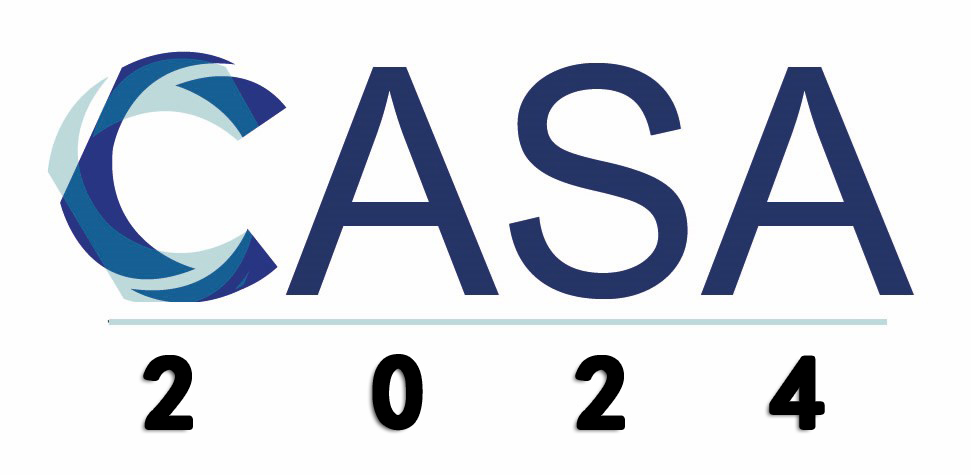Keynote Speakers

Nadia Magnenat Thalmann
Title: The AI Humanoid Robot Nadine: Our Next Social Assistant
Abstract: Nadine is a humanoid social robot that was created in Singapore at Nanyang Technological University (NTU) during 2013 to 2022. Since 2022, we have developed new research on Nadine at MIRALab, University of Geneva in Switzerland, particularly including Large Language Models (LLMs) In this talk, we will discuss the use of such robots in various situations as elderly home, Museum and Insurances and banks. We will show some research being done on memory, natural interaction and the use of LLMs that improves quite a lot the interaction. We will also discuss the coming future of such robots thanks to the intense development of AI, Rags. We will show some industrial development and future work.
Biography: Professor Magnenat Thalmann started
her career in Canada at the University of Montreal where she
pioneered the field of 3D Virtual Humans, particularly the
recreation of legendary stars in 3D. In 1989, she created the
laboratory MIRALab at the University of Geneva, a
ground-breaking research lab developing Virtual Humans and
Social Robots. From 2019 to 2022, she was the Director of the
research Center Beingthere and the Research Institute IMI in
Nanyang Technological University (NTU) in Singapore. In NTU,
Singapore, she revolutionized social robotics by unveiling the
first social robot Nadine that can show mood and emotions and
remember people and actions.
Besides having bachelor’s and master’s degrees in disciplines
such as psychology, biology, chemistry and computer science,
Professor Thalmann completed her PhD in quantum physics at the
University of Geneva. She has received honorary doctorates from
Leibniz University of Hannover and the University of Ottawa in
Canada and several prestigious other Awards as the Humboldt
Research Award in Germany, the Eurographics Career Award and the
Canadian Human Computer Communications Society Award. She is a
life Member of the Swiss Academy of Engineering Sciences. For
more information about her academic achievements, see google
scholar.

Kai Xu
Title: Learning Fast and Robust Point Cloud Registration
Abstract: 3D point cloud registration is a classic problem in 3D vision, robotics and computer graphics. It is widely used in scenarios such as robot picking, high-precision assembly, and 3D dimensional measurement in the field of intelligent manufacturing. Traditional point cloud registration methods are based on hand-crafted key points and feature descriptors, which have weak representation capabilities and low accuracy in situations such as noisy/missing data, severe occlusion, and low overlap. Point cloud registration based on deep learning has developed rapidly in recent years. I will report our recent works on point cloud registration based on deep learning, including the attention-based multi-level matching model, GeoTransformer, based on geometric structure encoding, the 2D-3D cross-modal multi-scale registration model 2D3D-MATR, the multi-instance point cloud registration model MIRETR based on local geometric context encoding, as well as the unsupervised RGB-D registration model NeRF-UR guided by neural radiance fields. At last, I will talk about the application of some of these methods in intelligent manufacturing scenarios.
Biography: Kai Xu is a Professor at the School of Computer, National University of Defense Technology, where he received his Ph.D. in 2011. During 2017-2018, he was a visiting research scientist at Princeton University. His research interests include geometric modeling and shape analysis, especially on data-driven approaches to the problems in those directions, as well as 3D vision and robotic applications. He has published over 100 research papers, including 29 SIGGRAPH/TOG papers. He serves on the editorial board of ACM Transactions on Graphics, Computers & Graphics, and The Visual Computer. He also served as program co-chair and PC member for several prestigious conferences. His research work can be found in his personal website: www.kevinkaixu.net.

Dongdong Weng
Title: The Role of Digital Humans in Human-Computer Interaction Technologies of the Intelligent Era
Abstract: In the age of intelligence, digital human interaction technology plays a key role, changing the way people interact with technology. This report explores the significance of digital human interaction technology in today's society and its extensive application across various scenarios. The multimodal digital humans of the future should possess human-like abilities to see, hear, speak, and process knowledge logically, taking the development of artificial intelligence a step closer to human-like processes. Through research and application of digital human interaction technology, we can better understand and leverage the potential of this field to promote the development and progress of the intelligent era.
Biography: Weng Dongdong is a researcher and
doctoral supervisor at Beijing Institute of Technology. He is
also the deputy director of the Key Laboratory of Immersive
Interactive Animation of the Ministry of Culture and Tourism,
and the deputy director of the Virtual Technology and
Application Professional Committee of the Chinese Simulation
Society. He drafted the first digital human industry standard in
China, and presided over the development of the first Beijing
Opera digital human project in China (Master Mei Lanfang). He
won the second prize of National Technological Invention of The
State Council, the first prize of science and technology
Progress of the Chinese Society of Image and Graphics, and the
first prize of technological invention of the Beijing Municipal
People's Government.
As the project leader, he has participated in and presided over
several key national research and development programs including
the "Multi-modal Virtual-Real Integration Human-Computer
Interaction System and Application Demonstration" and the "New
Wearable Somatosensory Interaction Device." He has also led
projects under the National Science and Technology Support
Program such as "Research on Imaging-Guided Minimally Invasive
Tumor Treatment Technology Systems" and "Research on Digital
Museum Handheld Device Guided Technology." Additionally, he has
directed research on "3D Point Cloud Visual Perception Driven
Large-Scale Outdoor Augmented Reality Theory and Methods" funded
by the National Natural Science Foundation of China, among other
scientific research projects.

Bo Ren
Title: Handle Complex Coupling and Interaction for Fluid Simulation in Computer Graphics
Abstract: While real-world fluids can have impressive visual appearances, the complexity in faithfully reproducing the exact phenomena has hounded the graphics community for decades. The difficulties arise from various aspects, from inter-phase interaction in multi-phase simulations, solid-liquid coupling near arbitrary geometries, to controllability of physically motion for artistical or AI uses. In this talk I will present some of our efforts in achieving stable, fast and controllable fluid simulation involving complex coupling and interaction, using both the traditional physically-based methodology and the latest learning-based one.
Biography: Bo Ren received the PhD degree from Tsinghua University in 2015. He is currently an associate professor in the College of Computer Science, Nankai University, Tianjin. His research interests include learning-based and physically-based simulation, neural reconstruction and generation of three dimensional contents. He is in the technical committee on CAD and Graphics of CCF, and the technical committee on intelligent graphics of CSIG.

Lei Bi
Title: Radiomics via Multi-Modal Image Analysis and Visualization
Abstract: Medical imaging plays a pivotal role in patient management in modern healthcare and most patients will benefit from some sorts of medical images. Radiomics refer to use high-thoughtput computing to extract quantitative features from large medical imaging datasets. These extracted features, known as radiomic features, are used to uncover patterns and characteristics that are often not visible to the naked eye. The challenge now is how to maximize the extraction of meaningful information from the medical images. There needs to be strategies to harness knowledge from medical image datasets and complementary sources like other imaging modalities, text-reports and human inputs. Despite rapid advancements in integrating machine learning algorithms into clinical decision support systems, we are still in the nascent stages of the machine learning revolution in radiomics. This talk presents our research on multi-modality learning to integrate imaging and complementary data for analysis, visualization and radiomics, aimed at improving the understanding of pathophysiology and precision treatment.
Biography: Dr Lei Bi is an associate professor with the Institute of Translational Medicine at the Shanghai Jiao Tong University. Prior to that, he was a lecturer with the School of Computer Science at the University of Sydney and was a research fellow at the Australia Research Council Training Centre for Innovative BioEngineering. He received his PhD degree from the University of Sydney in 2018. His current research focus is on multi-modality medical image analysis and visualization, and he collaborates alongside with hospital and industry partners to translate the research outputs into clinical applications. His research has produced excellent results including more than 60 papers in leading venues in the field such as in Medical Image Analysis, IEEE TMI, CVPR, MICCAI etc and has been listed as World’s Top 2% Scientists (Stanford University). He has received competitive research grants from government and industries such as the DAAD AINet Fellowship, Australian Tour de Cure early career research grant. Currently, he is an associate editor for Frontiers in Radiology, an associate editor for the Journal of Visual Computer, a guest editor for Computer Methods and Programs in Biomedicine and the organization chair for the 2023 Computer Graphics International Conference.
